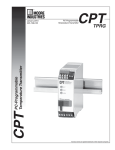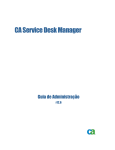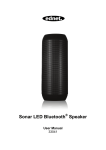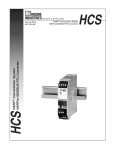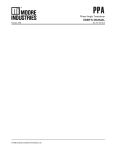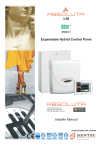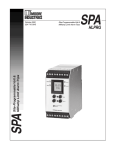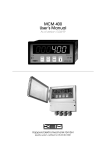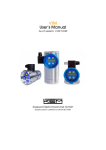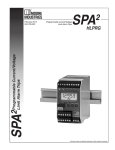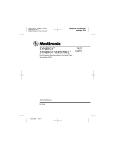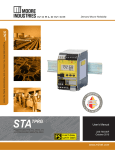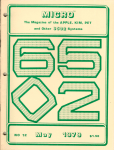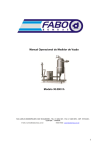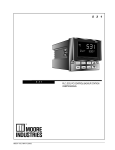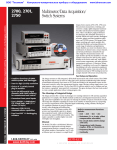Download HIM Manual.pmd - Gilson Engineering Sales Inc.
Transcript
HIM Smart HART® Loop Interface and Monitor April 2008 224-778-00E Smart HART ® Loop Interface and Monitor HIM Table of Contents Introduction ....................................................................................................... 4 About this Manual ............................................................................................................... 4 The HIM .............................................................................................................. 4 Model and Serial Numbers ................................................................................................. 4 Inputs .................................................................................................................................. 4 Outputs................................................................................................................................4 Options................................................................................................................................ 4 TX Power Supply ................................................................................................................ 4 HIM Dimensions................................................................................................ 5 Specifications ................................................................................................... 6 Configuring the HIM ......................................................................................... 7 Terminal Designations ........................................................................................................ 7 Installing the HIM .............................................................................................. 8 Installing the HIM into the Loop ........................................................................................... 8 Bench Checking the HIM .................................................................................................... 8 2 The Interface Solution Experts PC Configuration Software............................................................................11 HART Tab ......................................................................................................................... 12 Display Tab ....................................................................................................................... 14 Alarms Tab ....................................................................................................................... 15 Analog Outputs Tab .......................................................................................................... 17 Custom Curve Tab ............................................................................................................ 19 Scaling Tab ....................................................................................................................... 20 MODBUS Tab ................................................................................................................... 21 Installation .......................................................................................................26 Mounting ........................................................................................................................... 26 Making the Electrical Connections .................................................................................... 26 Recommended Ground Wiring Practices .......................................................................... 26 CE Conformity................................................................................................................... 26 Power Sourcing Parameters for General Locations, Intrinsically Safe and Non-Incendive/ Type N Applications.......................................................................................................... 26 Operation .........................................................................................................26 Maintenance ..................................................................................................................... 26 Customer Service ...........................................................................................26 The Interface Solution Experts 3 HIM Smart HART® Loop Interface and Monitor Introduction Outputs This is the user’s manual for the Moore Industries HIM Smart HART® Loop Interface and Monitor. It contains all of the information needed to configure, install, operate and maintain this instrument. The HIM can be ordered with the following outputs. About this Manual Pay particular attention wherever you see a “Note”, “Caution” or “WARNING ”. Note– Information that is helpful for a procedure, condition or operation of the unit. Caution– Hazardous procedure or condition that could damage or destroy the unit. WARNING – Hazardous procedure or condition that could injure the operator. 2AO / 3AO With this output, the HIM comes equipped with either two (2AO) or three (3AO) programmable analog output channels. MB Two redundant MODBUS RTU (RS-485) data links are available for use. MB1AO Provides two redundant MODBUS RTU (RS-485) data links with one analog output channel. The HIM Options The HIM allows up to three additional analog process variable measurements from a multivariable transmitter or valve with no additional process penetrations. Installed transparently across the 4-20mA instrument loop, the HIM reads the HART digital process data that rides on the loop wires. It converts the digital information for up to three isolated analog (4-20mA) process signals that are readily accepted by in-place control systems, such as a DCS or PLC. The following options may be ordered with the HIM: The HIM allows you to leave existing smart HART transmitters and valves in place, yet still take advantage of all the information they have to offer. Model and Serial Numbers Moore Industries uses the model and serial numbers of our instruments to track information on each unit that we sell and service. If a problem occurs with your HIM, check for a tag affixed to the unit listing these numbers. Supply the Customer Support representative with this information when calling. Inputs The HIM accepts a HART digital protocol input directly from a smart HARTmultivariable temperature, pressure, level, flow transmitter or from a valve positioner. 4 The Interface Solution Experts -1PRG / -2PRG One (-1PRG) or two (-2PRG) user-programmable alarm outputs; DPDT relay, 1 form C, rated 5A@250Vac, 50/ 60Hz, non-inductive (see Table 2 for details). CSA Approved for use in General/Ordinary Locations only. -FMEDA Unit comes with Failure Modes, Effects and Diagnostic Analysis (FMEDA) data for evaluating the instrument for suitability of use in a safety-related application. -RF Enhanced RFI/EMI protection (see Specifications for details) TX Power Supply A transmitter excitation (TX) power supply (regulated 24.0Vdc ±10%@24mA) is standard on the HIM. You may access it externally at the terminals shown in the installation drawings. HIM Smart HART® Loop Interface and Monitor Figure 1. The HIM Accepts a Digital HART Signal and Outputs Both Analog Signals and Alarm Relays Control System (DCS or PLC) HART Communicator can be connected anywhere along the 4-20mA loop (HART Secondary Master) 4-20mA Representing the Primary Variable (Mass Flow) HART Digital Signal Carrying Primary, Second, Third, Fourth Variable Process Data, and Instrument Diagnostic Information 4-20mA Proportional to 2nd Variable (DP) 4-20mA Proportional to 3rd Variable (P) HIM HART Interface Module "Breaks Out" Data from Smart HART Instruments (HART Primary Master) 4-20mA Proportional to 4th Variable (T) High Alarm in Response to 4th Variable (T) HART Transmitter Fault Alarm Smart HART Multivariable Mass Flow Transmitter Flow Figure 2. HIM Dimensions 65mm (2.56 in) T1 T2 T3 T4 T5 T6 133mm (5.25 in) 138mm (5.45 in) T7 T8 T9 T10 T11 T12 INPUT READY TRIP 1 TRIP 2 60.278 ADDR 0 DEG C COM B1 B2 B3 B4 B5 B6 HIM 100mm (3.94 in) HART INTERFACE MODULE B7 B8 B9 B10 B11 B12 The Interface Solution Experts 5 HIM Smart HART® Loop Interface and Monitor Specifications Indicators two-digit HART address Performance Input Accuracy: Reflects Performance ALARM OUTPUTS the accuracy of the HART (Continued) indicator (Continued) Digital Response Time: field device Defined by HART protocol as Format: Top row is five 500msec maximum in Normal Input Impedance: Transmit alphanumeric characters, Mode: 150 ohms; HART Mode; 333msec plus sign and decimal point; maximum in HART Burst Receive Mode: Less than bottom row is five 5kohms Mode alphanumeric characters Alarm Response Time: Decimal Points: UserANALOG OUTPUTS Digital Response Time + selectable for 0, 1, 2 or 3 150msec (Defined as time Output Accuracy: ±0.015% places after the decimal point of maximum output span from the field instrument’s or automatically adjusting with reporting a fault until the HIM (20mA). Includes the a four decimal point maximum combined effects of linearity, alarm is tripped) Range: -99999 to 99999 Alarm Trip Delay: hysteresis, repeatability and Minimum Display Span: adjustment resolution. Programmable from 0-120sec 1.00 Output Response Time: Display Update Rate: <120ms, 10-90% 100msec MODBUS OUTPUTS Isolation: 500Vrms channelLED Type: Dual color Type: Standard MODBUS to-channel isolation; red/green indicate: RTU protocol interface over 1000Vrms between case, INPUT LED: Whether (green) RS485 (parameters as input, outputs and power or not (red) the HART input is specified in U.S. Standard terminals, and will withstand connected and functioning EIA-RS485) 1500Vac dielectric strength properly Address Range: test for one minute with no READY LED: Whether Configurable from 1 to 247. breakdown (green) or not (red) the HIM is Unit will assume a MODBUS Ripple: Less than 10mV initialized and operating address of 01 by default peak-to-peak when properly Baud Rate: Interface measured across a TRIP 1 and 2 LED: Shows the supports the following: 300, 250 ohm resistor status of alarm off (green) or 600, 1200, 4800, 9600, 19.2k. Output Limiting: 130% of alarm on (red) MODBUS interface will span maximum; 125% of support even, odd and no span typical Ambient Operating and Storage parities. Unit will assume a Output Protection: baud rate of 9600 and no Conditions Range: Transient protection on -40°C to +85°C parity by default output (-40°F to +185°F) Character Format: One start Load Capability: Display Range: bit, 8 data bits and one stop 0-20mA, 1100 ohms -25°C to +85°C bit maximum (-13°F to +185°F) Data Format: UserLoad Effect: ±0.01% of span Relay Range: selectable Standard LSW from 0 to maximum load -25°C to +70°C (Least Significant Word) or resistance (-13°F to +158°F) Swapped MSW (Most Line Voltage Effect: Relative Humidity: Significant Word). Unit will ±0.005% of output span for a 0-95%, non-condensing assume Standard LSW by 1% change in line voltage Ambient Temperature default Input Fail Modes: PC Effect: ±0.0065% of Transmission Range: Using programmable to fail high, fail span/°C maximum 24AWG twisted pair wiring, low, hold last, hold last then RFI/EMI Immunity maximum of 2 mi. (3.2km)@ fail high, or hold last then fail (Standard): 4800 baud or less; maximum low (configurable hold time, 20V/m@20-1000MHz, 1kHz of 1 mi. (1.6km)@9600 baud; 0-60 seconds) AM, when tested according to maximum of 0.5 mi. (0.8km) Output Limits on Input IEC1000-4-3-1995 @19200 baud Failure: 0-20mA: Fail Low to RFI/EMI Immunity (with Power Consumption: 0mA or Fail High to 23.6mA; -RF Option): 30V/m@ 2-3.5W, nominal; 4.5W 4-20mA: Fail Low to 3.6mA 20-1000MHz, 1kHz AM, when @24Vdc maximum for units or Fail High to 23.6mA; tested according to IEC1000using transmitter excitation to X-20mA (0<X<4): Fail Low to 4-3-1995 supply loop power a 2-wire 90% of XmA or Fail High to Noise Rejection: Common instrument 23.6mA Mode: 100dB@50/60Hz +TX Power Supply: 24.0Vdc Indicators LCD Type: Two-line LCD; Weight 567 grams (16 ounces) ±10%@24mA Top Row, 10mm (0.4 in) high black digits on a reflective background; Bottom Row, 6mm (0.225 in) high digits on a reflective background; Specifications and information subject to change without notice. 6 The Interface Solution Experts HIM Smart HART® Loop Interface and Monitor Installing the PC Configuration Software Refer to Table 2 for the equipment needed. Configuring the HIM One of the benefits of the HIM is that there are no internal or external controls to adjust or settings to change. All operating parameters are set using the PC Configuration software. Once these software settings are made, they are downloaded to the monitor in the form of a Configuration File and stored in the unit’s non-volatile memory. You can choose to save a backup copy of the file on your PC hard drive or external media. The HIM communicates with the PC through a proprietary communications cable to the PC’s serial (COM) port. Begin by installing the PC Configuration Software. 1. Insert the Moore Industries Interface Solution PC Configuration Software CD into the CD drive of the PC. Access the CD and open the HIM PC Configuration Software folder. 2. Double-click the installation program located in the folder. Follow the prompts to correctly install the program. Once the Configuration Program is installed on the PC, the unit can be connected either into the loop or to test equipment to simulate input and monitor output. With the PC program, the user can then view and/or change its operating parameters. To begin the process, connect the HIM into the loop (see Installing the HIM into the Loop) or into a configuration setup (see Bench Checking the HIM). Table 1. Terminal Designations INPUT / OUTPUT T1 T2 T3 +TX +IN –IN +TX +IN –IN HART Input, 2 MODBUS Oututs and 1 Analog Output (MB1AO) +TX +IN –IN HART Input, 2 MODBUS Outputs (MB) +TX +IN –IN B1 B2 B3 T4 T5 T6 ALARM RELAYS / POWER Single Alarm (–1PRG) Dual Alarm (–2PRG) KEY: +IN/–IN = Current input to HIM from HART device +I/–I Source = Analog Source Output A/B = MODBUS Output NC/NC# = Normally Closed (+) DC/(-) DCC = 24VDC Connection NO1 CM1 NC1 CM1 Relay 1 NC1 T10 T11 T12 –I Sink (AO1) +I Source (AO3) –I Source –I Sink (AO3) or +I Sink (AO3) +I Source –I Source (AO2) or +I Sink (AO2) –I Sink +I Source –I Source (AO2) (AO1) or +I Sink (AO1) –I Sink (AO1) +I Source (AO) –I Source –I Sink (AO) or +I Sink (AO) A B A S MODBUS MODBUS MODBUS MODBUS 2 2 1 2 B MODBUS 1 S MODBUS 1 A B A S MODBUS MODBUS MODBUS MODBUS 2 2 1 2 B MODBUS 1 S MODBUS 1 No Label B4 B5 B6 NO2 NO2 +TX = Transmitter Excitation Current +I/–I Sink = Analog Sink Output NO/NO# = Normally Open CM/CM# = Common (AO#) = Analog Output B7 B8 No Label CM2 NC2 CM2 Relay 2 NC2 Relay 1 NO1 T9 –I Sink +I Source –I Source (AO2) (AO1) or +I Sink (AO1) No Label No Alarm T8 +I Source –I Source (AO2) or +I Sink (AO2) HART Input, 2 Analog Outputs (2AO) HART Input, 3 Analog Outputs (3AO) T7 No Label B9 B11 B12 (+) DC B10 (-) DCC Ground (+) DC (-) DCC Ground (+) DC (-) DCC Ground NOTES: 1. The standard Single Alarm unit (1PRG) utilizes a DPDT relay. 2. Terminal blocks can accommodate 14-22 AWG solid wiring (torque to 4 inch-pounds, maximum). The Interface Solution Experts 7 HIM Smart HART® Loop Interface and Monitor Installing the HIM There are two methods for connecting the HIM for configuration. The recommended method requires you to install the instrument into the loop before it is configured. The secondary method allows you to bench check the HIM by attaching it to test equipment that will simulate the input and monitor the output. Figure 4. Bench Checking the HIM Using and External Power Source to Power a Transmitter For a HART Transmitter, the resistor must be >250 and <1100 ohms. For a HART Receiver, such as a valve positioner, no resistor is necessary. 24Vdc Power + Sensor Input Installing the HIM into the Loop – + HART Field Device or Simulator – + R Multimeter +IN To install the HIM into the loop for configuration, use the equipment shown in Table 2. Refer to Figure 5 (to install without using the TX power supply) or Figure 6 (to install using the TX power supply). –IN – – + Optional INPUT READY TRIP 1 TRIP 2 ADDR 0 Bench Checking the HIM NC NO (+) DC COM Multimeter (-) DCC GND COM If you would like to configure the HIM before attaching it to the loop, you need to hook it up with the equipment listed in Table 1. Refer to Figures 3 and 4 for instructions on how to bench check the HIM either with or without taking advantage of the Transmitter Excitation (+TX) terminal. If you need further descriptions of the terminals, see Table 2. 24Vdc Power Checks for continuity Optional Table 2. Assembling the Necessary Equipment Device Figure 3. Bench Checking the HIM Using the Transmitter Excitation (+TX) Terminal to Power a Transmitter Specifications R must be > 250 and <1100 Ohms Precision Load Resistor Multimeter or Ammeter Power Supply 250 ohms, ±0.01% Accurate to ±0.009% of span, e.g. HP Model 3487A 24Vdc, ±10% Sensor Input – HART Field Device or Simulator + R +IN –IN +TX Equipment Hook-Up for HART field device using Transmitter Excitation INPUT READY + Multimeter + – TRIP 1 TRIP 2 ADDR Multimeter Moore Industries PC Configuration Software Communication Cable 8 Version 1.0 or higher, successfully installed to the hard drive Part Number: 803-053-26, or equivalent The Interface Solution Experts Checks for continuity Optional (+) DC (-) DCC GND NC COM Operating System: Microsoft Windows® 98, NT, 2000, Vista or XP, one serial port COM NO Personal Computer 0 Pentium-based PC, or equivalent with: CD Drive; 4Mb free RAM (8Mb recommended); 20Mb free disk space on hard drive (More RAM and hard disk space is required for Windows 98, NT, 2000 or XP) 24Vdc Power – HIM Smart HART® Loop Interface and Monitor Figure 5. Installing a HIM Into the Loop Using an External Power Source to Power a Transmitter HART Communicator can be connected anywhere on the loop ➤ ➤ 8 9 5 R must be > 250 and <1100 Ohms 6 2 3 . ➤ ➤ ➤ 7 4 1 0 ➤ — 24Vdc Power + Sensor Input ➤ – + R 4-20mA – +IN HART Multivariable Field Instrument (Temperature Pressure, Level and Flow) –IN INPUT READY DCS TRIP 1 TRIP 2 Analog Output tied to Any Process Variable ADDR 0 COM 25.1 COMMON GND (-) DCC (+) DC COM NO (normally open) NC NO deg-c 80.1 20.3 50.7 Event Recorder 24Vdc Power Source NC (normally closed) The Interface Solution Experts 9 HIM Smart HART® Loop Interface and Monitor Figure 6. Installing a HIM Into the Loop Using the Transmitter Excitation (+TX) Terminal to Power a Transmitter HART Communicator can be connected anywhere on the loop ➤ ➤ 8 6 2 3 . ➤ 9 5 0 ➤ ➤ 7 4 1 R must be > 250 and <1100 Ohms ➤ — ➤ Sensor Input – 4-20mA R +IN + +TX HART Multivariable Field Instrument (Temperature, Pressure, Level and Flow) –IN INPUT READY DCS TRIP 1 TRIP 2 Analog Output tied to Any Process Variable ADDR 0 COMMON NC (normally closed) 10 The Interface Solution Experts GND (-) DCC (+) DC COM NO (normally open) NC NO COM 24Vdc Power Source Event Recorder HIM Smart HART® Loop Interface and Monitor PC Configuration Software Figure 7. HIM PC Configuration Software Screen 3 2 1 The HIM PC Configuration Software can be used to program all of the HIM’s parameters. Once the default configuration has been saved, it is safe to program other parameters. The PC Software is made up of these sections: 1. HIM Status and Information Section–The left side of the screen includes seven boxes that display the different settings of the attached HIM. Program Status–Displays the activity of the connected HIM. It will show you if the unit is Idle, Uploading, Downloading, Monitoring or Searching. HIM Device Info–Displays the individual charac teristics of the attached HIM, such as its Identification, Hardware and Software Revisions, and the last date that the device was configured. HIM Tag–A phrase used to identify a HIM. HIM Device Status–Displays how the HIM is functioning, giving a brief summary of any errors or displaying OK if it is operating normally. HIM Displayed Data–this display mirrors what the attached HIM is displaying. Progress–This bar stays in motion any time the HIM is monitoring, uploading or downloading. Communication Status–monitors the PC Software’s ability to communicate with the HIM. 2. HART/Display/ Alarms/Analog Outputs/Custom Curve/ Scaling/MODBUS Tabs–These tabs change the right side of the screen to allow you to set the appropriate part of the HIM’s configuration. Refer to the associated pages in this document for additional information on these tabs. 3. Menu Bar/Tool Bar– Dropdown menus and corresponding icons allow you to perform various functions throughout the PC Configuration Program. The Interface Solution Experts 11 HIM Smart HART® Loop Interface and Monitor HART Tab To program the HART parameters, change the settings in the Communications Settings box, then press Quick Set. See the descriptions below of the various sections of the screen. HART Address The HART Address is the address of the HART device that the HIM will be monitoring. Number of Retries The Number of Retries can be set between 1 and 9, and will determine how many times the HIM will attempt to poll the HART transmitter (without success), before it indicates a HART Fault condition. Normal/Burst/Listen (Passive) Modes The HIM can operate in one of four modes: Normal, Burst, or Listen (Passive) and Listen (Specified Slave). In each of these modes, the HIM attempts to find a HART transmitter. In Normal mode, the HIM polls the HART loop for a transmitter, then polls the HART instrument twice per second, requesting the current process status and the HART instrument’s diagnostic status. The HART instrument responds with the requested data. In Burst mode, the monitored HART instrument is programmed to continuously transmit its process variable and health status. The HIM samples the continuous HART data three times per second. Listen (Passive) mode allows the HIM to operate on a loop that already has primary and secondary HART masters. In Listen (Passive) mode, the monitor connects passively, continuously sampling HART data from a smart instrument without affecting normal loop operation. When using this mode, either the monitored smart HART instrument must be set in Burst Mode or a HART master must be continuously polling the smart HART slave device. 12 The Interface Solution Experts The HART protocol allows for two communications masters on the loop, a Primary and a Secondary. Setting the HIM to function as the Primary HART Master in the application means that any other HART device in the loop must be configured either as a HART Secondary Master (1 per loop) or as a HART Slave (up to 16 per loop). Conversely, setting the HIM to function as the Secondary HART Master allows other HART devices to function either as a Primary Master or as slaves. Configuring more than one device on a single loop as a Primary or Secondary HART Master will cause a communications failure. Listen (Specified Slave) When multiple HART instruments are present, the Listen (Passive) mode cannot be used because data returned from one instrument will overwrite the data previously stored in the HIM. If multiple HART slave instruments are communicating on the loop, the HIM will overwrite its internal HART data sets with the latest device read from the bus, no matter where the data originates. To allow selective monitoring on a multiinstrument loop, and to allow multiple HIMs to be used on a digital loop, the Listen (Specified Slave) feature is used. If the HIM is in “Listen” mode it is not a HART communication master and therefore is not in control of communication. Other HART masters are controlling the polling of slaves and the HIM can only “Listen”. The HIM must be able to detect when it has not heard from its assigned slave device so that it can declare a “No HART” input and force outputs to the values specified by the user. The HIM must therefore be told to wait an appropriate amount of time for the slave device to send its message before the HIM declares “No HART”. This timing coordination is accomplished with Timeout Period. Timeout Period is a value between 1 and 30sec and must be greater than the period between polls by the HART master of the Specified Slave. For example, assume that there are five HART transmitters on the same multi-drop loop as the HIM. The HART master is configured to poll each device every second. It then takes the HART master five seconds to repeat the poll to the one device being monitored by the HIM. the HIM Timeout Period must be set at a value greater than five HIM Smart HART® Loop Interface and Monitor seconds. In this example, we will use seven seconds. The HIM then sees its slave device speak and waits seven seconds for it to speak again. As long as the HIM sees a new message from its slave device its outputs are updated based upon the measured variables. If the slave device does not speak within the seven second period, the HIM declares a “No HART” situation and sends its outputs to the failed communications values. To use this feature, proceed with the following steps: 1. Select the Listen (Specified Slave) button. 2. Enter your desired value into the Timeout Period(s) text box. Factory default is 5 seconds. The maximum Timeout Period is 30 seconds. 3. Set the exact slave address of the instrument you wish to monitor. Click the Set Slave Address button. This brings up the HART Slave Device Long Format Address Settings screen (Figure 8). Enter the required information into the appropriate text boxes. Figure 8. HART Slave Device Long Format Address Settings Screen The Manufacturer’s ID and Device Type ID for the instrument that the HIM will listen to are available from the HART Foundation website at www.hartcomm.org and/or the instrument manufacturer. Values obtained from the HART website are in HEX code. The HIM does not use HEX code; you must convert this value to Decimal code. To convert HEX to Decimal code, perform the following steps: Access the Calculator feature in Microsoft Windows® by opening the Start menu. Next, select Programs then Accessories and finally Calculator. Ensure that the Calculator is in Scientific mode. To do this, select the View dropdown menu and choose Scientific. Click the Hex radio button and enter the HEX code value. Next, click the Dec button and the value will be converted into the Decimal value. Enter the converted value into the proper param eter. The Device ID Number is the serial number of the exact device to which the HIM will listen. 4. Once complete, press OK. Download the information to your instrument once you are finished. Auto Clear Status Bit Most HART instruments indicate when a device's configuration has been changed. This indication (status bit) can be reset by sending HART command 38–reset configuration changed. Checking the Auto Clear Status Bit box causes the HIM to issue this command whenever the HART instrument it is monitoring has its configuration changed. However, the HIM can also be set to alarm on this bit (see Programming the Alarm Parameters). If the HIM is both set to alarm and to auto clear, then it will do both–going into alarm mode and resetting that indication. Quick Read/Set The Quick Read button causes the PC Configuration Software to read the communications information from the attached HIM; the Quick Set button causes the software to configure the HIM’s communications settings to match those of the PC Software. The Interface Solution Experts 13 HIM Smart HART® Loop Interface and Monitor HART Device Info This box displays the identification and revision information of the monitored HART instrument. HART Device Status The HART Device Status box displays the current status of the monitored HART transmitter. In a small double-box, the software displays the code (hex number) associated with the status. Variables The device will monitor up to the first four HART variables sent by your transmitter. This portion of the screen displays those variables and the Loop Current. HART Device Range & Limits This portion of the screen displays the range and the sensor limits of the monitored HART transmitter. Toggle, Variable List The Toggle checkbox causes the HIM to sequentially display two HART variables in five second increments. Directly below the Toggle checkbox are two list boxes to select the variables that you would like to be displayed. Notice that if you select a scaled variable, it is important to check on the Scaling page to verify that you have set all of the scaling parameters. Use Custom Label The Custom Label is used to display a calculated or scaled variable. Clicking the Use Custom Label box causes the HIM to always display the custom label as Engineering Units (EGUs). Precision The Precision buttons allow you to change the number of decimal places displayed by the HIM. Quick Set The Quick Set button programs the HIM with the information on the Display page. Display Tab The Display tab configures the HIM’s LCD display. To program the Display parameters, change the settings in the Display Source box, then press Quick Set. See the following descriptions of the various sections of the screen. Figure 9. Display Tab 14 The Interface Solution Experts Display Format The HIM reads the dynamic process variable supported by HART sensors. Generally, the HIM’s LCD displayed values range from -99999 to 99999. Occasionally, these process variable values may extend past this range. To improve the displayed readings, values below -XXXXX and above XXXXX are translated into exponential form. Below is an example of the appearance of the display when certain values are sensed. Value Display 12345 12345 1234500 -500000 1.23E06 -5.00E05 HIM Smart HART® Loop Interface and Monitor Alarms Tab The Alarms tab controls the programmable alarm trip(s) option. This screen will be grayed out if the attached HIM is not equipped with at least one alarm trip. To program the Alarm parameters, change the settings in the Alarm1 and/or Alarm2 box, then press Quick Set. The sections of the screen are described below. Figure 10. Alarms Tab Device Malfunction (Bit 7) Relay trips whenever it detects that a hardware error or failure has occurred in the connected HART device. Configuration Changed (Bit 6) Relay trips whenever it detects that the connected HART device has had its configuration changed. Cold Start (Bit 5) Relay trips whenever the power to the HART device is interrupted. It will also trip during a HART Master Reset or Self Test Command. Additional Status (Bit 4) Relay trips whenever the connected HART device reports a condition requiring HART Command #48, which is Read Additional Information. This indicates that the instrument needs attention from a device with full HART command capability. Output Current Fixed (Bit 3) Relay trips whenever the HIM detects that the connected HART device’s output is no longer responding to changes in its input, and is being held at a predefined level. Trip/Fault Alarms A Trip Alarm monitors a selected variable and trips either when the variable exceeds a set value (Trip High) or when the variable falls below a selected value (Trip Low). The Source specifies which variable will be monitored, while the Trip Point sets the point at which the alarm will trip. After the alarm trips, the Dead Band determines how far past the trip point the variable will have to go before the alarm condition returns to normal. There are two types of Fault Alarms. A HIM Fault Alarm monitors the health of the HART monitor. It will trip whenever the internal error status word is set. For example, if the HIM’s configuration file becomes corrupt, this alarm will trip and the monitor will display BAD_CONFIG. A Field Device Fault Alarm monitors the health of the HART transmitter. This fault alarm will trip for any of these eight malfunctions: PV Analog Output Saturated (Bit 2) Relay trips whenever it detects that both its analog and digital representations of the Primary Variable are outside rated operating limits, and no longer reflect the true sensor input. Non-PV Out of Limits (Bit 1) Relay trips whenever one of the HART ancillary variables (second, third or fourth), is operating outside the limits that can be effectively measured. PV Out of Limits (Bit 0) Relay trips whenever the HART Primary Variable is operating outside the limits that can be effectively measured. Delay & Fail Safe By entering a value in the Delay box, you can specify how long (in seconds) the alarm condition needs to exist before the alarm trips. Failsafe alarms (box checked) de-energize when in alarm condition; Non-Failsafe alarms energize when tripped. The Interface Solution Experts 15 HIM Smart HART® Loop Interface and Monitor HART Additional Status Alarm Bits Figure 11. Additional HART Status Alarm Bits Settings Window HART Additional Status also called “More Status” and “Command 48” is where device manufacturers install the custom diagnostics for the specific device. For your particular application, you may choose all of these diagnostics to cause the HIM relay to trip or just one diagnostic bit to trip the HIM relay (or any combination in between). The manufacturer of the HART device will be the source for the specific diagnostic information. Selecting the Field Device Fault Alarm function in the Alarms screen allows you to enable the HIM to set alarm states, when in fault mode, based on the bit settings of the additional status information returned by certain HART instruments. This provides flexibility to the requirement of alarming on additional status information. Choosing this feature, you are given the ability to specify the bit(s) on which to alarm. To access this feature, check the Additional Status box. The Edit button will appear in the HART Additional Status Bits section of the screen. Clicking the Edit box brings up the Additional HART Status Alarm Bits Settings window (Figure 11). Check the box(es) that correspond to the bits you wish to use; click OK. Download the information to your instrument once you are finished. 16 The Interface Solution Experts Read & Quick Set Buttons The Read button causes the PC Configuration Software to read the alarm information from the attached HIM; The Quick Set button causes the software to configure the HIM's alarm settings to match those currently entered in the PC Software. HIM Smart HART® Loop Interface and Monitor Analog Outputs Tab The HIM comes with either two (–2AO) or three (–3AO) analog outputs. The Analog Outputs tab allows you to specify which HART variable is to be monitored as the source of the analog output, the input range and output range, and how the output will react when the variable input is out of range. To program the Analog Outputs parameters, change the settings in the Output1/2/3 boxes, then press Quick Set. See the descriptions below of the various sections of the screen. Figure 12. Analog Outputs Tab For example, you have a vortex flow meter with an imbedded RTD that measures the process temperature, and that temperature is assigned to the HART Secondary Variable. The full range of the RTD sensor is from –400°F to +1760°F, but your flow stream will always be between 0° and 400°F. To scale the analog output, for Output 1, set the Source as SV. Set the Input Range to 0° and 400°F, and the Output Range to 4mA to 20mA. Click Quick Set to download the new configuration file to the HIM. Output Current Box The Output Current Box on the Analog Outputs Tab displays up-to-the-second information on the value, in mA, of the analog output. Fail Mode The Fail Mode setting determines how the HIM will respond when its monitored input fails. If Fail Mode is set to High and the measured input goes out of range, or any detected error occurs in the HART transmitter, the analog output will output a 23.6mA signal. If Fail Mode is set to Low and the measured input goes out of range, or any detected error occurs in the HART transmitter, the analog output will output a signal that is 90% of the lower range value below 4mA; it will output 0mA if the lower range is set to 0mA. Source Source defines the variable that the analog output will monitor. Notice that selecting one of the scaled outputs will require you to make changes to the Scaling tab, and selecting the Custom Curve option will require you to make changes to the Custom Curve tab. Input/Output Range The Input or Output Range defines the range of the source input and the range of the analog output. These two sets of fields can be used to scale the HIM’s output. If Fail Mode is set to Hold Last, the HIM will continue to output the last value it recorded before the input failed. If Fail Mode is set to Hold Last Then High or Hold Last Then Low, the HIM will continue to output the last value recorded for a set amount of time (according to Hold Last Duration box), then either fail high or fail low, respectively. Quick Set Button The Quick Set button causes the software to configure the instrument’s analog output settings to match those currently entered in the PC Software. Trim Button The Trim button brings up the Trim Menu, allowing you to set the device’s output to match the reading of the loop. Refer to the Programming the Trimming Parameters section of this manual for more information. The Interface Solution Experts 17 HIM Smart HART® Loop Interface and Monitor Configuring Analog Output Trimming The Analog Output Trimming section of the software allows you to match the HART monitors analog output to the output measured by a calibration device. This will require a calibrated multimeter, such as a HP Model 3478A or equivalent, accurate to ±0.009%. Note: Trimming the analog output of the monitor nullifies any scaling that may have been performed in the Scaling tab. Figure 13. Trimming Window User Trimming To trim the device, attach a multimeter to the analog output, then click the Fix Output at Low Point button. Read the value on the multimeter, enter it into the Measured Output Loop Current portion of the Trimming box, and press Trim. Repeat this sequence until the analog output matches the minimum point (4mA for a 4-20mA output) when you click the Fix Output at Low Point button. After the low point is trimmed, press the Fix Output at High Point button. Read the value on the multimeter, enter it into the Measured Output Loop Current portion of the Trimming box, and press Trim. Repeat this sequence until the analog output matches the maximum point (20mA for a 4-20mA output) when you click the Fix Output at High Point button. When finished, press the Unfix Output button. 18 The Interface Solution Experts Fix Current Utility The Fix Current Utility allows you to force the HIM to output any current value from 0-20mA. This can be used to match the calibration of your other equipment. To fix the current, simply enter the value in the Current box (in mA) that you want the HIM to output, and click Fix Output. When you are finished, make sure to press the Unfix Output button so that the HIM can return to normal operation. HIM Smart HART® Loop Interface and Monitor Custom Curve Tab The custom curve tab allows you to set up a custom curve of up to 128 points. A custom curve can either be created from scratch or loaded from a previously created comma separated value (.csv) file. To program the Analog Outputs parameters, change the settings in the Custom Curve tab, then press Download Table. See the descriptions below of the various sections of the screen. Figure 14. Custom Curve Tab Custom Curve Variable The Custom Curve Variable displays up-to-the-second information on the value of the Custom Curve. Press the Monitor button to display the variable information. Custom Curve The middle section of the screen displays the custom curve table. After enabling custom curve mode and setting the variable to be monitored, continue by selecting the number of points for the curve. Enter the actual linearization points into the custom curve table, inserting the source variable into the X Column, and the corresponding data (i.e. the °C, °F, Gallons, PSIG, Millimeters, etc.) into the Y Column. Note: When entering data in the linearization table, make sure that you enter a number into every open cell. Custom Curve File These buttons allow you to manipulate custom curve files, including the important Save Table command that will save a table to your hard drive. Upload Table Moves a custom curve file from the connected HIM to the PC Software for editing or storage. Download Table Configures the HIM by downloading the custom curve table from the PC Software to the HIM. Mode Check the Enabled box to begin programming the custom curve. Source Variable The Source Variable defines the variable that the custom curve will calculate. Notice that if you select a scaled variable, you may need to click on the Scaling tab and verify the settings for your scaled variable. Quick Set The Quick Set button causes the software to configure the HIM’s custom curve settings to match those currently entered in the PC Software. Save Table Saves a displayed custom curve table to memory on your computer’s hard drive. Load Table Loads a previously saved custom curve table. Clear Table Clears the displayed custom curve table. When you have finished changing all your settings, download the information to the HIM using the Download Table button. If you have selected a scaled variable, you should also click on the Scaling tab and set the scaling parameters. The Interface Solution Experts 19 HIM Smart HART® Loop Interface and Monitor Figure 15. Scaling Tab Scaling Tab The Scaling tab allows you to configure the values for scaled variables. To scale the selected variable, enter the values into the appropriate boxes, then click on the Transfer menu and click Download to transfer the new scaled values to the HIM. (If any scaled variable was selected in the Display, Alarm or Analog Outputs tabs, then the corresponding scaled variable section will become active for editing). The HIM’s versatile scaling feature has many possible applications, as is shown in the illustration below. Suppose you are using a digital pressure (DP) transmitter to measure the level of a tank in either centimeters/inches or PSI. Since the tank is only 300 centimeters (10 feet) high, the full range of the primary variable (PV) output from the DP transmitter is 0-4.3 PSI. You want to display the full level range (in centimeters/inches of water) on the HIM. You also need to control the level from 50% to 100%, since the tank must be at least 50% full at all times. Finally, your existing loop indicator and level controller needs 4-20mA to represent 150 to 300 centimeters (60 to 120 inches) of water. How do you do this? Scaling Illustration 1. Since you want to display the full level range in inches of water (in H2O) on the HIM, and the HIM is reading PSI as the primary variable, first go to the Display tab and select Scaled PV as your display source. 2. Go to the Scaling tab and set up the PV Zero and PV Full values, and the Scaled PV Zero and Full values. PV Zero would be 0 (PSI) and PV Full would be 4.3 (PSI). Scaled PV would correlate to zero being 0 in H2O and full being 120 in H2O. The HIM should now (after downloading) display the full range in in H2O. 3. To manipulate the HIM’s analog output, go to the Analog Outputs tab. Select Scaled PV as the Output 1 source. Since you need to control the level from 50% to 100%, the Input Range should be 60 to 120 in H2O and the Output Range should be 4mA to 20mA. Figure 16. The HIM’s Scaling feature works to get the most out of your existing process instruments Control level range (50% to 100% of total level) Full Primary Variable range (in PSI) Loop Display (reads 0-100% of control level) 4-20mA Signal Digital Pressure Transmitter 20 The Interface Solution Experts HART Signal HART Monitor (120 PSI) 4-20mA Signal Controller maintaining control from 50-100% of full scale (60-120 inH 2 0/2.15-4.3 PSI). 4-20mA from HART Monitor should represent 60-120 inH 2 0. HIM Smart HART® Loop Interface and Monitor MODBUS Tab The HIM PC program allows you to configure the HART monitor. A HART Monitor with MODBUS output provides a digital MODBUS output to a connected MODBUS-based controller. Selecting the MODBUS tab allows you to set the MODSBUS communications parameters. Notice that the MODBUS tab will only be available in units with MODBUS configuration. Figure 17. MODBUS Tab Floating Point Word Order By default, the HART monitor will use the Standard LSW (least significant word) floating point word order format. This stores the most significant bits in the second register and the least significant bits in the first register. Selecting Swapped MSW (most significant word) will reverse the order, storing the most significant bits in the first register and the least significant bits in the second register. Failed Slave’s Register Value You may select what would occur to a slave device’s register value in the event that communication is lost with the HIM. If selecting Hold Last and a failure is detected, the last measured value before the failure occurred is held. Entering a user-set value in the Preset to text box recalls that value when a slave device failure is detected. Selecting NaN (Not a Number–as put forth by the IEEE-754 standard) causes the floating point NaN value to be stored in the registers used for holding floating point values. Comms Settings The Comms Settings include the following: MODBUS Address The MODBUS Address is the number that the HIM monitor uses to identify itself on the MODBUS network. The MODBUS address is configurable from 1 to 247. By default, it will assume a MODBUS address of 01. Baud Rate The Baud Rate is the speed of data transmission. It should be set to match the baud rate of the attached controller. The interface supports the following baud rates: 300, 600, 1200, 2400, 4800, 9600 and 19200. Acquire Slave Device Additional Status Information Checking the Always acquire box will allow the Additional Status information to be displayed in the corresponding MODBUS register (refer to Table 3). If the box remains unchecked, Additional Status information will be unavailable. If this information is not needed, it is good practice to keep the box unchecked in order to keep polling of the additional status bytes from occurring. This will help maintain faster response times. MODBUS Registers The HART Monitor outputs a MODBUS signal to the attached controller. To access the MODBUS registers for variable, input/output or error information, refer to Tables 3 and 4 for more information. Parity The HART monitor supports even, odd and no Parity. The data format is one start bit, 8 data bits and one stop bit. The Interface Solution Experts 21 HIM Smart HART® Loop Interface and Monitor Figure 18. Installing a HIM with MODBUS output into the loop using the Transmitter Excitation (+TX) terminal HART Communicator can be connected anywhere on the loop R must be > 250 ohms and <1100 ohms Sensor Input – 4-20mA R +IN + A +TX HART Field Instrument (Temperature, Pressure, Level, Flow Multivariable) B –IN INPUT READY S DCS TRIP 1 TRIP 2 60.278 ADDR DEG C 0 RS485 / RS232 Converter COM COMMON TO serial (COM) port of PC MODBUS Host GND (-) DCC (+) DC COM NO (normally open) NC NO MODBUS output (with MODBUS option) 24Vdc Power Source NC (normally closed) MODBUS 0ffsets (where applicable) Table 3 contains (zero based) MODBUS addresses . Your MODBUS host may require you to enter the MODBUS register. Often MODBUS registers have an offset of “1” from the MODBUS address. For example, a MODBUS address listed below of 256 may have to be entered as 257 in your host. Please refer to your MODBUS host documentation for verification. 22 The Interface Solution Experts HIM Smart HART® Loop Interface and Monitor Table 3. MODBUS register definitions Register Range Description 0 HART Primary variable 1 HART Secondary variable 2 HART Third variable 3 HART Fourth variable 4 PV scaled 5 SV scaled 6 TV scaled 7 FV scaled 8 Linearized variable 9 Analog Output 1 current x 100mA 10 Analog output 2 current x 100mA 11 Analog output 3 currentx 100mA 12 HIM Status Information Bit 0 = hardware failure Bit 1 = EEPROM fail Bit 2 = EEPROM configuration checksum error Bit 3 = EEPROM calibration checksum error Bit 4 = EEPROM blank Bit 5 = Out of range error Bit 6 = Division by zero error Bit 7 = Configuration data bad error Bit 8 = COP SW fail Bit 9 = RAM test fail Bit 10-13 = not used Bit 14 = HART device malfunction status bit set Bit 15 = No HART communications status 13 HART status information (as per HART specification) 14 HART instrument PV EGU (MSB = 0, LSB = HART EGU code) 15 HART instrument SV EGU (MSB = 0, LSB = HART EGU code) 16 HART instrument TV EGU (MSB = 0, LSB = HART EGU code) 17 HART instrument QV EGU (MSB = 0, LSB = HART EGU code) 18 Device ID MSW The Interface Solution Experts 23 HIM Smart HART® Loop Interface and Monitor Table 3. Continued 19 Device ID LSW 20 HART Device Manufacturer ID 21 HART Device, device type code 22 HART device, device ID MSW 23 HART Device, device ID LSW 24 HIM Alarm Status (Bit 0 = alarm 1, Bit 2 = alarm 2) 25 Additional Status Byte 0 26 Additional Status Byte 1 27 Additional Status Byte 2 28 Additional Status Byte 3 29 Additional Status Byte 4 256-257 HART Primary variable (float format) 258-259 HART Secondary variable (float format) 260-261 HART Third variable (float format) 262-263 Hart Fourth variable (float format) 264-265 Scaled Primary variable (float format) 266-267 Scaled Secondary variable (float format) 268-269 Scaled Third variable (float format) 270-271 Scaled Fourth variable (float format) 272-273 Linearized varialbe (float format) 274-275 Analog output 1 current (float format) 276-277 Analog output 2 current (float format) 278-279 Analog output 3 current (float format) Note: Trimming the analog output of the monitor nullifies any scaling that may have been performed in the Scaling tab. 24 The Interface Solution Experts HIM Smart HART® Loop Interface and Monitor Table 4. System status registers MSB/LSB Description Bit Position Int 16 (16 bit integar) Bit 7 HART device no comms Bit 6 HART device malfunction Bit 0 HW fail Bit 1 EEPROM fail Bit 2 EEPROM checksum error Bit 3 EEPROM calib data error Bit 4 EEPROM blank Bit 5 out of range value Bit 6 division by zero Bit 7 bad configuration MSB = device status LSB = device error code Table 5. Slave device status Status Bit Description 0 Primary variable out of limits 1 Non-Primary variable out of limits 2 Analog output #1 saturated 3 Analog output #1 fixed 4 More status available 5 Cold start 6 Configuration changed 7 Field device malfunction The Interface Solution Experts 25 HIM Smart HART® Loop Interface and Monitor Installation Installation consists of physically mounting the unit and completing the electrical connections. Mounting The HIM is designed to snap easily onto 32mm, Gtype (EN50035) or 35mm Top Hat (EN50022) DIN-rails. Making the Electrical Connections After mounting, you are ready to connect the HIM to the loop. Each unit comes equipped with a transmitter excitation terminal which allows it to supply power to the monitored HART instrument, if necessary. Figures 5 and 6 show the connection diagrams for an HIM with or without using the transmitter excitation current. Recommended Ground Wiring Practices Moore Industries recommends the following ground wiring practices: • Any Moore Industries product in a metal case or housing should be grounded. • The protective earth conductor must be connected to a system safety earth ground before making any other connections. • All input signals to, and output signals from, Moore Industries’ products should be wired using a shielded, twisted pair technique. Shields are to be connected to an earth or safety ground at the unit itself. • The maximum length of unshielded input and output signal wiring should be 2 inches. CE Conformity Installation of any Moore Industries products that carry the CE certification (Commission Electrotechnique) must adhere to the guidelines in the Recommended Ground Wiring Practices section in order to meet the requirements set forth in the applicable EMC (Electromagnetic Compatibility) directive 89/336/EEC, EN 61326. Consult the factory for the most current information on products that have been CE certified. 26 The Interface Solution Experts Power Sourcing Parameters for General Locations, Intrinsically Safe, and Non-Incendive/Type N Applications In accordance with IEC 1010.1 Annex H (all models), the input terminals must be connected to and/or supplied from a certified energy limiting Class 2 or a Separate Extra Low Voltage (S.E.L.V.) power supply separated from all mains by double/reinforced insulation. Operation Once programmed, calibrated, installed, and supplied with the correct power, the instrument begins to operate immediately. Depending upon environmental conditions, it can be expected to operate unattended for extended periods of time. Maintenance Moore Industries suggests a check for terminal tightness and general unit condition every 6-8 months. Always adhere to any site requirements for programmed maintenance. Customer Support If service assistance is ever required for an instrument in your application, refer to the back cover of this manual for the telephone numbers to Moore Industries’ STAR Center customer service department. If possible, make a note of the model number of the offending unit before calling. For fastest assistance, have the following available: serial number and the job and purchase order number under which it was shipped. Declaration of Conformity EMC Directive 89/336/EEC • Manufacturer’s Name: • Manufacturer’s Address: Moore Industries-International, Inc. 16650 Schoenborn Street North Hills, CA 91343-6196 USA Declares that the product(s): • Product Name: HIM MODEL / • Model Number(s): HIM INPUT / OUTPUT * * / POWER * / OPTIONS / * HOUSING * * Indicates any input, output, power, option and housing as listed on the product data sheet • Conforms to the following EMC specifications: EN 61326-1, 1998, Electromagnetic Compliance (EMC) requirements for electrical equipment for control use. • Supplementary Information: None June 20, 2003 Date Fred Adt Quality Assurance Director Robert Stockham Moore Industries-Europe General Mgr. European Contact: Your Local Moore Industries Sales and Service Office United States • [email protected] Tel: (818) 894-7111 • FAX: (818) 891-2816 Australia • [email protected] Tel: (02) 8536-7200 • FAX: (02) 9525-7296 Belgium • [email protected] Tel: 03/448.10.18 • FAX: 03/440.17.97 The Netherlands • [email protected] Tel: (0)344-617971 • FAX: (0)344-615920 China • [email protected] Tel: 86-21-62491499 • FAX: 86-21-62490635 United Kingdom • [email protected] Tel: 01293 514488 • FAX: 01293 536852 RETURN PROCEDURES To return equipment to Moore Industries for repair, follow these four steps: 1. Call Moore Industries and request a Returned Material Authorization (RMA) number. Warranty Repair – If you are unsure if your unit is still under warranty, we can use the unit’s serial number to verify the warranty status for you over the phone. Be sure to include the RMA number on all documentation. Non-Warranty Repair – If your unit is out of warranty, be prepared to give us a Purchase Order number when you call. In most cases, we will be able to quote you the repair costs at that time. The repair price you are quoted will be a “Not To Exceed” price, which means that the actual repair costs may be less than the quote. Be sure to include the RMA number on all documentation. 2. Provide us with the following documentation: a) A note listing the symptoms that indicate the unit needs repair b) Complete shipping information for return of the equipment after repair c) The name and phone number of the person to contact if questions arise at the factory 3. Use sufficient packing material and carefully pack the equipment in a sturdy shipping container. 4. Ship the equipment to the Moore Industries location nearest you. The returned equipment will be inspected and tested at the factory. A Moore Industries representative will contact the person designated on your documentation if more information is needed. The repaired equipment, or its replacement, will be returned to you in accordance with the shipping instructions furnished in your documentation. WARRANTY DISCLAIMER THE COMPANY MAKES NO EXPRESS, IMPLIED OR STATUTORY WARRANTIES (INCLUDING ANY WARRANTY OF MERCHANTABILITY OR OF FITNESS FOR A PARTICULAR PURPOSE) WITH RESPECT TO ANY GOODS OR SERVICES SOLD BY THE COMPANY. THE COMPANY DISCLAIMS ALL WARRANTIES ARISING FROM ANY COURSE OF DEALING OR TRADE USAGE, AND ANY BUYER OF GOODS OR SERVICES FROM THE COMPANY ACKNOWLEDGES THAT THERE ARE NO WARRANTIES IMPLIED BY CUSTOM OR USAGE IN THE TRADE OF THE BUYER AND OF THE COMPANY, AND THAT ANY PRIOR DEALINGS OF THE BUYER WITH THE COMPANY DO NOT IMPLY THAT THE COMPANY WARRANTS THE GOODS OR SERVICES IN ANY WAY. ANY BUYER OF GOODS OR SERVICES FROM THE COMPANY AGREES WITH THE COMPANY THAT THE SOLE AND EXCLUSIVE REMEDIES FOR BREACH OF ANY WARRANTY CONCERNING THE GOODS OR SERVICES SHALL BE FOR THE COMPANY, AT ITS OPTION, TO REPAIR OR REPLACE THE GOODS OR SERVICES OR REFUND THE PURCHASE PRICE. THE COMPANY SHALL IN NO EVENT BE LIABLE FOR ANY CONSEQUENTIAL OR INCIDENTAL DAMAGES EVEN IF THE COMPANY FAILS IN ANY ATTEMPT TO REMEDY DEFECTS IN THE GOODS OR SERVICES , BUT IN SUCH CASE THE BUYER SHALL BE ENTITLED TO NO MORE THAN A REFUND OF ALL MONIES PAID TO THE COMPANY BY THE BUYER FOR PURCHASE OF THE GOODS OR SERVICES. United States • [email protected] Tel: (818) 894-7111 • FAX: (818) 891-2816 Australia • [email protected] Tel: (02) 8536-7200 • FAX: (02) 9525-7296 © 2006 Moore Industries-International, Inc. ANY CAUSE OF ACTION FOR BREACH OF ANY WARRANTY BY THE COMPANY SHALL BE BARRED UNLESS THE COMPANY RECEIVES FROM THE BUYER A WRITTEN NOTICE OF THE ALLEGED DEFECT OR BREACH WITHIN TEN DAYS FROM THE EARLIEST DATE ON WHICH THE BUYER COULD REASONABLY HAVE DISCOVERED THE ALLEGED DEFECT OR BREACH, AND NO ACTION FOR THE BREACH OF ANY WARRANTY SHALL BE COMMENCED BY THE BUYER ANY LATER THAN TWELVE MONTHS FROM THE EARLIEST DATE ON WHICH THE BUYER COULD REASONABLY HAVE DISCOVERED THE ALLEGED DEFECT OR BREACH. RETURN POLICY For a period of thirty-six (36) months from the date of shipment, and under normal conditions of use and service, Moore Industries ("The Company") will at its option replace, repair or refund the purchase price for any of its manufactured products found, upon return to the Company (transportation charges prepaid and otherwise in accordance with the return procedures established by The Company), to be defective in material or workmanship. This policy extends to the original Buyer only and not to Buyer's customers or the users of Buyer's products, unless Buyer is an engineering contractor in which case the policy shall extend to Buyer's immediate customer only. This policy shall not apply if the product has been subject to alteration, misuse, accident, neglect or improper application, installation, or operation. THE COMPANY SHALL IN NO EVENT BE LIABLE FOR ANY INCIDENTAL OR CONSEQUENTIAL DAMAGES. Belgium • [email protected] Tel: 03/448.10.18 • FAX: 03/440.17.97 The Netherlands • [email protected] Tel: (0)344-617971 • FAX: (0)344-615920 China • [email protected] Tel: 86-21-62491499 • FAX: 86-21-62490635 United Kingdom • [email protected] Tel: 01293 514488 • FAX: 01293 536852 Specifications and Information subject to change without notice.




























